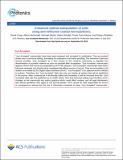Files in this item
Enhanced optical manipulation of cells using anti-reflection coated microparticles
Item metadata
| dc.contributor.author | Craig, Derek | |
| dc.contributor.author | McDonald, Alison | |
| dc.contributor.author | Mazilu, Michael | |
| dc.contributor.author | Rendall, Helen Anne | |
| dc.contributor.author | Gunn-Moore, Frank J | |
| dc.contributor.author | Dholakia, Kishan | |
| dc.date.accessioned | 2016-09-11T23:34:13Z | |
| dc.date.available | 2016-09-11T23:34:13Z | |
| dc.date.issued | 2015 | |
| dc.identifier | 199650531 | |
| dc.identifier | 1082ffcf-9bd9-480d-b4d2-c5fa665c5442 | |
| dc.identifier | 84945567686 | |
| dc.identifier | 000363435600002 | |
| dc.identifier.citation | Craig , D , McDonald , A , Mazilu , M , Rendall , H A , Gunn-Moore , F J & Dholakia , K 2015 , ' Enhanced optical manipulation of cells using anti-reflection coated microparticles ' , ACS Photonics , vol. 2 , no. 10 , pp. 1403-1409 . https://doi.org/10.1021/acsphotonics.5b00178 | en |
| dc.identifier.other | ORCID: /0000-0003-3422-3387/work/34730419 | |
| dc.identifier.uri | https://hdl.handle.net/10023/9469 | |
| dc.description | The authors thank the UK Engineering and Physical Sciences Research Council under grants EP/J01771X/1 and EP/M000869/1, the University of St Andrews, the BRAINS 600th anniversary appeal and Dr. Killick for funding. | en |
| dc.description.abstract | We demonstrate the use of anti-reflection (AR) coated microparticles for the enhanced optical manipulation of cells. Specifically, we incubate both CHO-K1 and HL60 cell lines with AR coated titania microparticles and subsequently performed drag force measurements using optical trapping. Direct comparisons were performed between native, polystyrene microparticle and AR microparticle tagged cells. The optical trapping efficiency was recorded by measuring the Q value in a drag force experiment. CHO-K1 cells incubated with AR microparticles show an increase in the Q value of nearly 220% versus native cells. With the inclusion of AR microparticles, cell velocities exceeding 50um/s were recorded for only 33mW of laser trapping power. Cell viability was confirmed with fluorescent dyes and cells expressing a fluorescent ubiquitination-based cell cycle protein (FUCCI) which verified no disruption to the cell cycle in the presence of AR microparticles. | |
| dc.format.extent | 826131 | |
| dc.language.iso | eng | |
| dc.relation.ispartof | ACS Photonics | en |
| dc.subject | Optical trapping | en |
| dc.subject | Dielectric tagging | en |
| dc.subject | Anti-reflection | en |
| dc.subject | Microparticles | en |
| dc.subject | Biophotonics | en |
| dc.subject | Cell viability | en |
| dc.subject | QB Astronomy | en |
| dc.subject | QC Physics | en |
| dc.subject | DAS | en |
| dc.subject.lcc | QB | en |
| dc.subject.lcc | QC | en |
| dc.title | Enhanced optical manipulation of cells using anti-reflection coated microparticles | en |
| dc.type | Journal article | en |
| dc.contributor.sponsor | EPSRC | en |
| dc.contributor.sponsor | EPSRC | en |
| dc.contributor.institution | University of St Andrews. School of Physics and Astronomy | en |
| dc.contributor.institution | University of St Andrews. School of Biology | en |
| dc.contributor.institution | University of St Andrews. Institute of Behavioural and Neural Sciences | en |
| dc.contributor.institution | University of St Andrews. Biomedical Sciences Research Complex | en |
| dc.identifier.doi | 10.1021/acsphotonics.5b00178 | |
| dc.description.status | Peer reviewed | en |
| dc.date.embargoedUntil | 2016-09-11 | |
| dc.identifier.grantnumber | EP/M000869/1 | en |
| dc.identifier.grantnumber | EP/J01771X/1 | en |
This item appears in the following Collection(s)
Items in the St Andrews Research Repository are protected by copyright, with all rights reserved, unless otherwise indicated.

